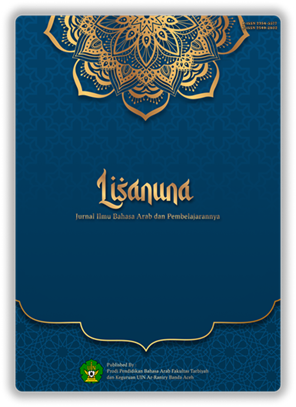Integrasi Higher Order Thinking Skills Dalam Pembelajaran Bahasa Arab
DOI:
https://doi.org/10.22373/ls.v15i1.30381Keywords:
Higher Order Thinking Skills, Arabic Language Teaching.Abstract
The skills of Indonesian students in higher-order thinking, or Higher Order Thinking Skills (HOTS), in various dimensions are still far from what is expected. It is suspected that the main factor behind this low skill level is that these HOTS dimensions are still not clearly defined. This issue becomes even more unsolvable because teachers, as planners, implementers of teaching and learning activities in the classroom, and the front-line assessors of learning outcomes, have not yet enhanced their knowledge and abilities in HOTS concepts and their implementation. In teaching foreign language subjects, such as Arabic, the integration of HOTS is considered even more challenging due to the nature of the subject, which focuses more on vocabulary learning, language rules, and language skills, often relying solely on lower-order thinking skills. For the Arabic language subject to contribute to building HOTS in students, a reorientation of learning that integrates both language learning objectives and HOTS learning objectives is needed. This formulation of the reorientation of Arabic language learning is carried out by reviewing the theories and frameworks of cognitive processes and knowledge content, and then trying to formulate the orientation of Arabic language learning and adopting other foreign language learning practices. One aspect of this reorientation is to integrate learning activities with teaching materials and instructional procedures that facilitate students in learning, practicing, and absorbing the dimensions of HOTS. With this reorientation, it is hoped that the Higher Order Thinking Skills learning component will become an integral part of Arabic language learning in the classroom.
Downloads
References
Al-Naqah, Mahmud Kamil, Ta’limu al-Lughati al-Arabiyyati li al-Nathiqina bi Lughatin Ukhra: Asasuhu, Madakhiluhu, Thuruqu Tadrisuhu, al-Mamlakah al-Arabiyyah al-Su’udiyyah: Jami’ah Um al-Qura, 1985
Anderson, L.W. & Krathwohl, D.R. (Eds) A taxonomy for learning, teaching and assessing: A revision of Bloom’s taxonomy of educational objectives. (New York: Longman, 2000)
Cangelosi, James S., Systematic Teaching Strategies, New York: Longman, 1992
Haladyna, Thomas M., Writing Test Items to Evaluate Higher Order Thinking, Boston: Allyn and Bacon, 1997
https://www.kompasiana.com/darwonogurukita/higher-order-thinking-skills-guru_5836d9dd537b610c0b8e6d20, diakses tanggal 3 Maret 2025
Hughes, John, Critical Thinking in the Language Classroom, ttp: ELI, 2014
Shirkhani, Servat dan Mansour Fahim, “Enhancing Critical Thinking in Foreign Language Learners”. Procedia – Social and Behavioral Sciences,Vol. 29, 2011, h.111-115. Diakses pada tanggal 2 Nopember 2017 dari situs: https://www.sciencedirect.com/science/article/pii/ S1877042811026759
Trilling, Bernie & Charles Fadel, 21st Century Skills: Learning for Life in Our Times (San Fransisco: Jossey-Bass, 2009)
Downloads
Published
Issue
Section
License
Copyright (c) 2025 Asyraf Muzaffar

This work is licensed under a Creative Commons Attribution-ShareAlike 4.0 International License.
1. Proposed Policy for Journals That Offer Open Access Authors who publish with this journal agree to the following terms:
1.a. Authors retain copyright and grant the journal right of first publication with the work simultaneously licensed under a Creative Commons Attribution License that allows others to share the work with an acknowledgement of the work's authorship and initial publication in this journal.
1.b. Authors are able to enter into separate, additional contractual arrangements for the non-exclusive distribution of the journal's published version of the work (e.g., post it to an institutional repository or publish it in a book), with an acknowledgement of its initial publication in this journal.
1.c. Authors are permitted and encouraged to post their work online (e.g., in institutional repositories or on their website) prior to and during the submission process, as it can lead to productive exchanges, as well as earlier and greater citation of published work (See The Effect of Open Access).
2. Proposed Policy for Journals That Offer Delayed Open Access Authors who publish with this journal agree to the following terms:
2.a. Authors retain copyright and grant the journal right of first publication, with the work [SPECIFY PERIOD OF TIME] after publication simultaneously licensed under a Creative Commons Attribution License that allows others to share the work with an acknowledgement of the work's authorship and initial publication in this journal.
2.b. Authors are able to enter into separate, additional contractual arrangements for the non-exclusive distribution of the journal's published version of the work (e.g., post it to an institutional repository or publish it in a book), with an acknowledgement of its initial publication in this journal.
2.c. Authors are permitted and encouraged to post their work online (e.g., in institutional repositories or on their website) prior to and during the submission process, as it can lead to productive exchanges, as well as earlier and greater citation of published work (See The Effect of Open Access).

